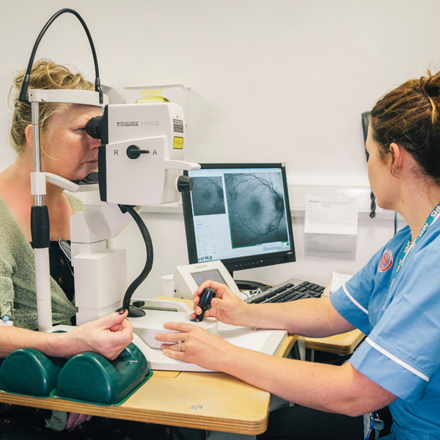Breakthrough in artificial intelligence (AI) helps detect dry AMD
Posted: Thursday 09 September 2021
Researchers at Moorfields Eye Hospital have developed the first-ever fully automated algorithm, which can detect dry age-related macular degeneration (AMD) using common eye scans.
The development will not only allow faster diagnosis of dry AMD, but will also help researchers develop successful treatments for the condition.
Using optical coherence tomography (OCT) scans the team trained an algorithm to recognise the early signs, precise localisation and progression of dry AMD automatically. They then tested this against a different set of OCT scans from patients at Moorfields Eye Hospital to compare results.
Currently, to diagnose dry AMD, experts must examine patients manually, using a series of time-consuming tests. OCT results must then be examined by clinicians to determine the precise nature of the condition. This can take up to one hour per eye scan andcan be prone to human error and variability.
The in-house algorithm was able to match, and outperform, predictions made by specialist clinicians, all in a fraction of a second.
The team, which was lead by Dr Konstantinos Balaskas at Moorfield Eye Hospital’s Reading Centre, hope the algorithm will be hugely beneficial to clinicians providing care for patients with dry AMD. It will provide a reliable and fast way to assess the severity of the condition, how fast it progresses and how well it responds to emerging new treatments.
It is also hoped further research will lead to an algorithm that can predict progression to dry AMD in otherwise healthy patients, which could allow future preventive treatment to be administered at the earliest opportunity.
Dr Balaskas said: “We are the first academic/reading centre to develop an AI tool to do this. Developing it in-house and doing so at a standard required for publication in one of the top medical journals is a major accomplishment for our team, Moorfields, UCL and the NIHR.
“We hope it is a major step towards an effective treatment pathway for geographic atrophy, which affects millions of people worldwide and often leads to debilitating sight loss.”
The current research builds on Moorfields’ earlier success in the development of AI, which can predict whether people with dry AMD will develop the wet form of the condition.
The findings from the recent research have been published in Lancet Digital Health.
What is an algorithm?
For a computer to do anything, you have to write a computer program. This involves telling the computer, step by step, exactly what you want it to do. The computer then follows each step mechanically, to accomplish what it has been asked to do.
When you are telling the computer what to do, you also get to choose how it's going to do it. That's where computer algorithms come in. An algorithm is the list of instructions and rules that a computer needs to do to complete a task.
